Atlanta Chinese Dance Company
presented
Ming, Gu, Xian
***click above for program synopsis***
on
Saturday, September 11, 2004 at 7:30 PM
Sunday, September 12, 2004 at 3:00 PM
at
The Performing Arts Center at Gwinnett Center
Duluth, Georgia
Staged and Directed by:
Hwee-Eng Y.
Lee
Guest Artists:
Ray Garcia
Tara Lee (Atlanta Ballet)
Tian Shuai (Atlanta Ballet)
Tamila (Atlanta Ballet)
MING: CHINESE FOLK ("MING
JIAN") DANCE
Chinese folk dance evoled from the movements of the common people.
The dances reflect the lifestyles of the villagers, ranging from work to social
life to their interaction with nature. Classified by geographic location,
the scope of Chinese folk dance encompasses many different ethnicities in China,
including the Hang majority and the fifty-six minority ethnic groups in China,
most notably the Zhuang, Dai, Xinjiang, and Tibetan minorities. The "Ming"
section revolves around the famous Chinese folktale "Pull the Carrot." Two
village girls plant a carrot that has grown so big that they don't know what to
do with it. With a group effort, however, they eventually pull the carrot
out of the ground. Proud of their efforts, they invite their neighbors of
different ethnicities to join in their celebration.
THE VILLAGE GIRLS AND THE MONKEYS
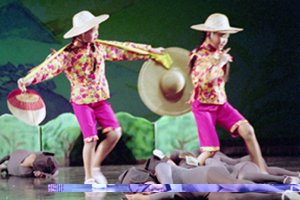 Two
girls carry hats and fans from their house to sell. As they leave, they
water the carrot in their garden. All of the sudden, they encounter a
group of monkeys. The monkeys rob them of all of their goods, which
naturally makes the girls angry, but the clever girls think of a way to take
back their hats and fans. Year 2004 was the Chinese lunar new year of the
monkey.
Two
girls carry hats and fans from their house to sell. As they leave, they
water the carrot in their garden. All of the sudden, they encounter a
group of monkeys. The monkeys rob them of all of their goods, which
naturally makes the girls angry, but the clever girls think of a way to take
back their hats and fans. Year 2004 was the Chinese lunar new year of the
monkey.
Choreography:
Hwee-Eng Y. Lee
Village Girls: Kateri Goodwin and
Anna Meyer (Saturday), Tiffany Liu and Christie Sui (Sunday)
Monkeys: Sophie Archer, Emily Backer, Mei-Jing Bernard, Laura Brockmann,
Marjorie Peace Huan Chamberlain, Christy Chang, Claire Chang, Molly Herman-Gallow,
Kate Zahniser-Word
[Top of page]
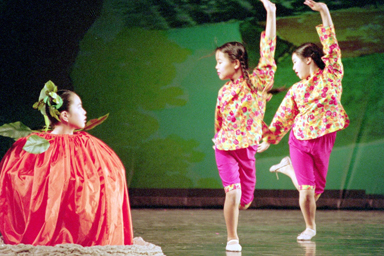 PULL
THE CARROT!
PULL
THE CARROT!
 The
folktale "Pull the Carrot!" has been passed down from generation to generation.
A young girl has grown a gigantic carrot. She tries unsuccessfully to pull
it alone. With the help of her friends, she is finally able to pull this
huge carrot out of the ground. Although this story is seemingly simple, it
has a very important underlying theme: although a daunting task may seem
impossible, much can be accomplished with perseverance and the aid of one's
friends.
The
folktale "Pull the Carrot!" has been passed down from generation to generation.
A young girl has grown a gigantic carrot. She tries unsuccessfully to pull
it alone. With the help of her friends, she is finally able to pull this
huge carrot out of the ground. Although this story is seemingly simple, it
has a very important underlying theme: although a daunting task may seem
impossible, much can be accomplished with perseverance and the aid of one's
friends.
Choreography: Hwee-Eng Y. Lee
Carrot: Lindsey Lue
Dancers: Kateri Goodwin (lead-Saturday), Anna Meyer (lead-Sunday), Amelia
Brockmann, Vera Chang, Madeleine Morgan Lan Harris, Tiffany Liu, Leslie Lue,
Christie Sui
[Top of page]
XINJIANG
DANCE: PICKING GRAPES
 Xinjiang,
located in the northwestern part of China, is the home of the Uighur (or "wei wu
er") ethnic group. The province is renowned for its fruit and produce,
including grapes and melons. This dance depicts a group of young ladies
picking grapes. The interesting wrist and neck movements are the main
characteristics of this style.
Xinjiang,
located in the northwestern part of China, is the home of the Uighur (or "wei wu
er") ethnic group. The province is renowned for its fruit and produce,
including grapes and melons. This dance depicts a group of young ladies
picking grapes. The interesting wrist and neck movements are the main
characteristics of this style.
Choreography: Hejireheman
Dancers: Grace Liang (lead),
Yolanda Campbell, San Tso Hsieh, Tzu-Wei Hsu, Jane Lee, Emily Pau, Angela Wang,
Mei-Yuan Wang
[Top of page]
THE LITTLE
PEPPER GIRL
 This
playful dance, of the majority Han ethnicity, depicts a girl planting peppers.
Because the peppers are very hot, the girl sneezes repeatedly. This dance
depicts the daily life of a young Chinese village girl.
This
playful dance, of the majority Han ethnicity, depicts a girl planting peppers.
Because the peppers are very hot, the girl sneezes repeatedly. This dance
depicts the daily life of a young Chinese village girl.
Dancer: Penny Wang
[Top of page]
PEACOCK
DANCE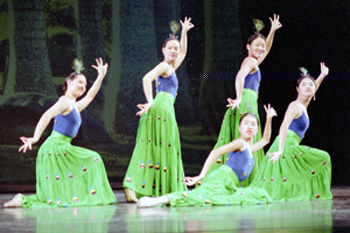
Peacocks symbolize happiness and good luck for the Dai minority
ethnicity, who reside mostly in the Yunnan province of southwest China.
Since the Dai live in close proximity to Myanmar, the style of Dai dance is
influenced by the Burmese. Bouncy knees and angular arms and fingers are
special characteristics of Dai dance. In this dance, the graceful peacock
is depicted drinking water, bathing, and flying.
Choreography: Hwee-Eng Y. Lee
Dancers: Queena Kou, Emily Pau, Amanda Phingbodhipakkiya, Joy Shieh,
Emily Sun
[Top of page]
BOAT
LOVERS
This
dance of the majority Han ethnicity depicts a young boatman and his girlfriend.
Through their flirtatious gestures, this dance exemplifies their love and care
for each other. The girl mends the boatmen's torn clothes while the
boatmen ferries her across the river.
Choreography: He Dabing
Boatman: Ray Garcia (Guest Artist)
His Girlfriend: Hoyi Chan
[Top of page]
RICE HARVEST
 Rice
is a staple crop of China. In this dance of the majority Han ethnicity a
group of young village girls harvest their crop using authentic sieves.
The lyrics of the song tell how much each grain of rice requires hard work under
the blazing hot sun.
Rice
is a staple crop of China. In this dance of the majority Han ethnicity a
group of young village girls harvest their crop using authentic sieves.
The lyrics of the song tell how much each grain of rice requires hard work under
the blazing hot sun.
Choreography: Yang Hua
Dancers: Sophie Archer, Emily Backer, Mei-Jing
Bernard, Laura Brockmann, Marjorie Peace Huan Chamberlain, Christy Chang, Claire
Chang, Ruby Freeman, Molly Herman-Gallow, Lacey Krakowiak, Rachel Leong, Ashley
Wang, Kate Zahniser-Word
[Top of page]
 NORTHEAST
FAN DANCE
NORTHEAST
FAN DANCE
This dance is a type of Yang
Ge from northeastern China. Yang Ge is the traditional folk art of the Han
people. Even though styles of Yang Ge differ by geographic location, they
mostly express the feeling of joy. The fan and the scarf are two of the
most popular props used in Yang Ge.
Dancers: Catherine Chu, Karen Ho,
Stephanie Hu, Allison Kwan, Lindsey Lue, Julia Shyu, Tanya Su, Alice Yee, Amy
Yee
[Top of page]
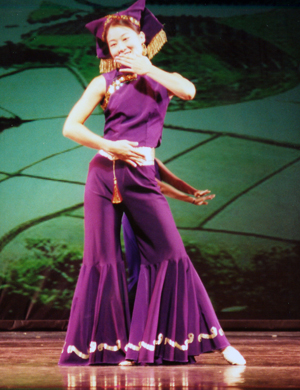 ZHUANG DANCE
ZHUANG DANCE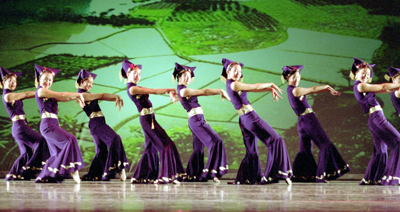
The Zhuang minority is the largest minority ethnic
group in China. Unique to this minority ethnicity is their distinctive
hat. Their dance styles include swinging movements and covering the mouth
with the hand.
Choreography: Wang Hanxiong and
Huang Xiuhong (Guangxi Song and Dance Ensemble)
Dancers: Joy Shieh (lead), Hoyi Chan, Queena Kou, Eugenie Ooi, Amanda
Phingbodhipakkiya, Tiffany Soo, Emily Sun, Joann Wang, Penny Wang
[Top of page]
 TIBET
DANCE
TIBET
DANCE
Most Tibetans live in the
western part of China in places like Tibet, Qinghai, Yunnan, Gansu, and Sichuan.
Their clothing typically includes a multi-colored apron and long sleeves.
They sometimes wear only one sleeve, as the weather can change rapidly in a
single day. This dance depicts the energetic spirit of the Tibetans.
Choreography: Xian Arts School
Dancers: Yolanda Campbell, Nancy Chen, Ava Chun, Debbie Ellis, Ludmilla
Harker, Jully Lai, Agate Lip, Holly Lyu, Iyabo Shabazz, Pai Tsai, Shu-Fen Yang,
Yinghui Zhong
[Top of page]
DAI DANCE
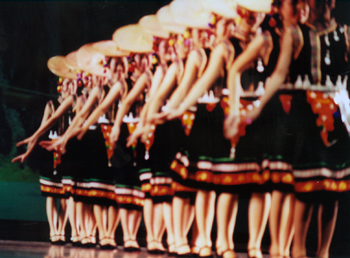
The Dai minority people live in a tropical climate,
and they often wear a hat in their daily lives. Such hats have become an
important prop in Dai folk dance. The lead dancers carry an instrument
called the "hulusi," which originated from the Dai culture.
Choreography: Yang Kejia and Wang
Xiaodong (Yunnan Song and Dance Ensemble)
Hulusi Dancers: San Tso Hsieh, Queena Kou, Emily Pau, Emily Sun
Hat Dancers: Grace Ho, April Huang, Deanna Joe, Dana Lee, Eugenie Ooi,
Catherine Stoddard, Melissa Ting, Ginger Tsai, Emily Wang, Lacey Wen, Kimberly
Wu, Cindy Ye
[Top of page]
RED RIBBON
DANCE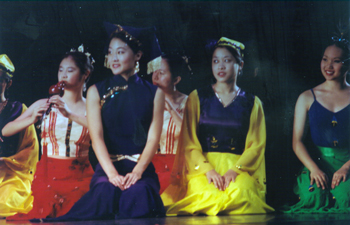
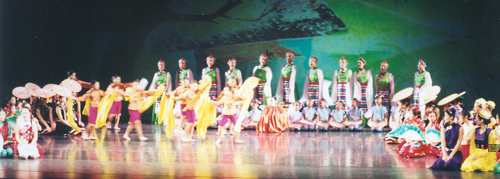 Traditionally,
red is the symbol of happiness. For centuries, the Chinese have taken
great pride in producing beautiful silk ribbons. Ribbon dancing originated
from Chinese opera and has been preserved since the Han dynasty (206 BC-24 AD).
It has since become a Han ethnic tradition, commonly performed at celebrations
such as Chinese New Year. Here the girls celebrate their success with the
huge carrot by inviting their friends of different ethnicities to take part in
the festivities.
Traditionally,
red is the symbol of happiness. For centuries, the Chinese have taken
great pride in producing beautiful silk ribbons. Ribbon dancing originated
from Chinese opera and has been preserved since the Han dynasty (206 BC-24 AD).
It has since become a Han ethnic tradition, commonly performed at celebrations
such as Chinese New Year. Here the girls celebrate their success with the
huge carrot by inviting their friends of different ethnicities to take part in
the festivities.
Choreography: Hwee-Eng Y. Lee
Dancers: Amelia Brockmann, Vera
Chang, Kateri Goodwin, Madeleine Morgan Lan Harris, Tiffany Liu, Leslie Lue,
Anna Meyer, Christie Sui
[Top of page]
GU: CHINESE CLASSICAL ("GU
DIAN") DANCE
Chinese classical dance celebrates the beauty of the classical Chinese
lady as represented by mural painters and poets of the Tang Dynasty (618-907
AD). As three girls embark on a journey into the caves of the Gansu
province, they come across the ancient mural paintings of Dunhuang. As the
ladies in the painting come alive in their minds, the stage is transformed into
a heavenly setting with flying celestials surrounding them from all sides.
The glorious female warrior Mulan shows another side of the classical Chinese
lady.
INTRODUCTION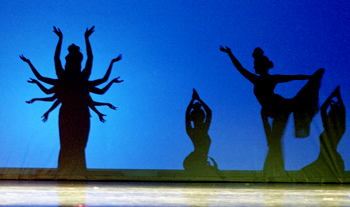
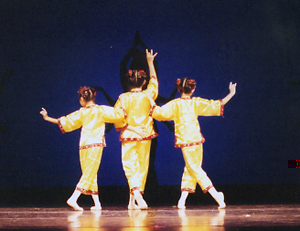
Three
young girls walk into a cave in the Gansu province. To their surprise,
they see mural paintings depicting Buddha statues with many hands.
Choreography: Gansu Song and
Dance Troupe and Hwee-Eng Y. Lee
Three Girls: Catherine Chu, Tanya Su, Amy Yee
Buddhas: Grace Ho, April Huang, Deanna Joe, Dana Lee, Catherine Stoddard,
Melissa Ting, Ginger Tsai, Emily Wang, Lacey Wen, Kimberly Wu, Cindy Ye
[Top of page]
 DUNHUANG
DANCE: FLYING CELESTIALS
DUNHUANG
DANCE: FLYING CELESTIALS
Dunhuang music and dance developed during
the Tang dynasty, one of the richest periods in Chinese Arts history. The
classical Dunhuang dance style developed during the introduction of Buddhism
into China and shows an Indian influence. This Dunhuang style dance is an
excerpt from the dance drama Along the Silk Road. It depicts
fairies flying in the heavens, watching the people on the earth below.
Staged after Gansu Song and Dance
Troupe's Along the Silk Road by Hwee-Eng Y. Lee
Dancers: Hoyi Chan, Queena Kou, Amy Liu, Eugenie Ooi, Amanda
Phingbodhipakkiya, Joy Shieh, Tiffany Soo, Emily Sun, Joann Wang, Penny Wang
[Top of page]
DANCE OF THE LOTUS
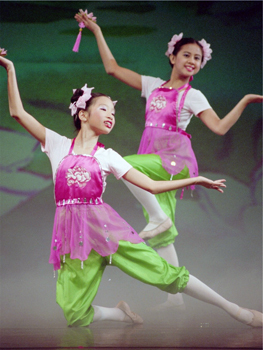

Also of the Dunhuang style, this dance is another excerpt from Along
the Silk Road. The lotus represents purity and is highly associated
with Buddhism. This dance depicts the lotus fairies dancing in heaven
Staged after Gansu Song and Dance
Troupe's Along the Silk Road by Hwee-Eng Y. Lee
Dancers: Catherine Chu (lead), Karen Ho, Stephanie Hu, Allison Kwan,
Lindsey Lue, Julia Shyu, Tanya Su, Alice Yee, Amy Yee
[Top of page]
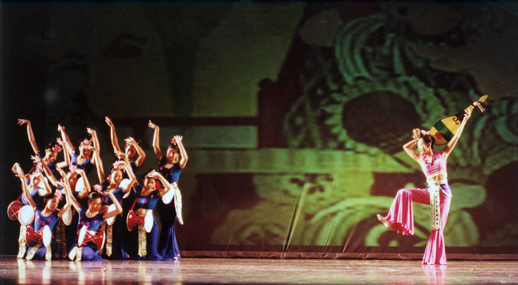 DUNHUANG
PIPA AND DRUM
DUNHUANG
PIPA AND DRUM
This dance introduces two popular
instruments of Dunhuang--the pipa, a Chinese stringed instrument, and the drum.
The pipa dancers uses the style called "fantanpipa," literally translated as
"playing the pipa backwards." This dance was typically performed in the
palace for the emperor.
Choreography: Chinese Central Music
and Dance Ensemble
Pipa Dancer: Eugenie Ooi
Drum Dancers: Grace Ho, April Huang, Deanna Joe, Dana Lee, Catherine
Stoddard, Melissa Ting, Ginger Tsai, Emily Wang, Kimberly Wu, Cindy Ye
[Top of page]
ODE TO MULAN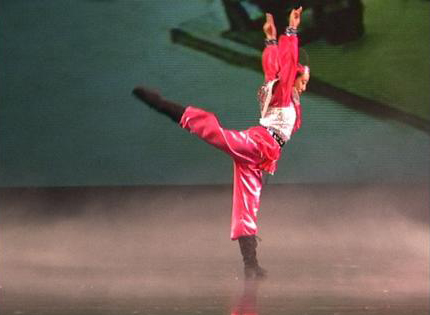
 The
well-known story of Mulan tells of a young girl who went to war in place of her
father. This dance uses the recitation of the famous poem "Ode of Mulan"
in conjunction with background music. The story of Mulan as it is told
today comes directly from the words of this poem. Using classical Chinese
dance technique combined with wushu (Chinese martial arts), this dance
characterizes both Mulan's feminine and masculine sides.
The
well-known story of Mulan tells of a young girl who went to war in place of her
father. This dance uses the recitation of the famous poem "Ode of Mulan"
in conjunction with background music. The story of Mulan as it is told
today comes directly from the words of this poem. Using classical Chinese
dance technique combined with wushu (Chinese martial arts), this dance
characterizes both Mulan's feminine and masculine sides.
Click
here
for the words of "Ode of Mulan"
Choreography: Shanghai Dance Schools
Dancer: Kerry Lee
[Top of page]
SWORD DANCE

Military sword technique gradually
developed into a form of dance. During the Tan dynasty, sword dancing was
already quite advanced in the palace. Movements in sword dancing are
forceful yet elegant. The solo dancer uses a sleeve in one hand and the
sword in the other, which enhances the beauty and difficulty of the dance.
Choreography: Hwee-Eng Y. Lee
Solo Dancer: Mei-Yuan Wang
Group Dancers: San Tso Hsieh, Jane Lee, Grace Liang, Emily Pau, Angela
Wang
[Top of page]
XIAN:
CHINESE CONTEMPORARY ("XIAN DAI") DANCE
Yellow River Piano Concerto
Chinese contemporary dance is a fusion of traditional Chinese dance and
modern dance. Set to the well-known "Yellow River Piano Concerto," this
section symbolizes the meeting between Chinese and western cultures in both
music and dance. The music was arranged for piano and orchestra after the
longer "Yellow River Cantata" by Xian Xinghai, who wrote the work as an act of
patriotism during the Sino-Japanese War. Each movement represents a
different aspect of the struggle of mankind with the horrendous flooding of the
Yellow River (or "Huang He" in Chinese), known by the Chinese people both as a
symbol of the continuity of Chinese civilization and as China's sorrow.
The ACDC's "Yellow River Piano Concerto" is an expanded version of the piece by
the same name presented as a part of In Search of the Imperial Palace in
May 2003. It features props used in Chinese dance, including ribbons,
fans, scarves, sleeves, and umbrellas.
PRELUDE:
THE SONG OF THE YELLOW RIVER BOATMEN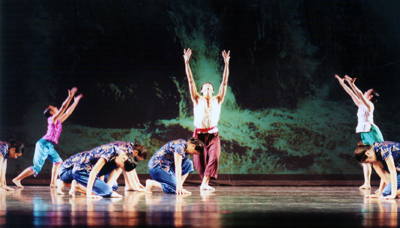

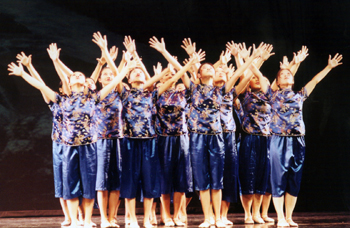 The first movement depicts the
courage of the Yellow River boatmen who struggle against the river. The
work songs of the boatmen show the strong-willed fighting spirit of the Chinese
people. The slower section shows the boatmen's optimistic view of their
grueling struggle. Shortly after, the mood reverts to tension.
The first movement depicts the
courage of the Yellow River boatmen who struggle against the river. The
work songs of the boatmen show the strong-willed fighting spirit of the Chinese
people. The slower section shows the boatmen's optimistic view of their
grueling struggle. Shortly after, the mood reverts to tension.
Choreography: Zhang Yujun and
Shen Peiyi (Beijing Dance Academy)
Lead Dancers: Jane Lee, Grace Liang, Angela Wang, Mei-Yuan Wang
Additional Dancers: San Tso Hsieh, Tzu-Wei Hsu, Kerry Lee, Tara Lee
(Guest Artist, Atlanta Ballet), Amy Liu, Emily Pau, Amanda Phingbodhipakkiya,
Tian Shuai (Guest Artist, Atlanta Ballet), Tamila (Guest Artist, Atlanta Ballet)
Children: Amelia Brockmann, Vera Chang, Catherine Chu, Kateri Goodwin,
Madeleine Morgan Lan Harris, Karen Ho, Stephanie Hu, Allison Kwan, Tiffany Liu,
Leslie Lue, Lindsey Lue, Anna Meyer, Julia Shyu, Tanya Su, Christie Sui, Alice
Yee, Amy Yee
[Top of page]
ODE
TO THE YELLOW RIVER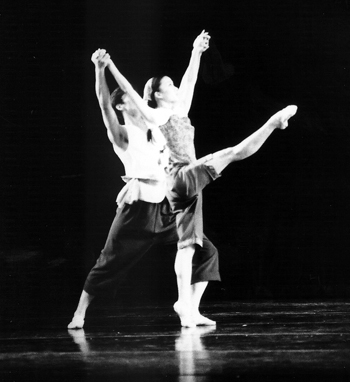


Starting with the
cello's opening, the music of the second movement depicts the achievements of
China's long history and its gorgeous landscape. Its praises the
traditions of the Chinese people who have lived on the banks of the Yellow River
for thousands of years.
Choreography:
Zhang Yujun and Shen Peiyi (Beijing Dance Academy)
Pas de deux: Tara Lee (Guest Artist,
Atlanta Ballet) and Tamila (Guest Artist, Atlanta Ballet)
Group dancers: Hoyi Chan, San Tso Hsieh, Tzu-Wei Hsu, Queena Kou, Jane
Lee, Grace Liang, Amy Liu, Eugenie Ooi, Emily Pau, Amanda Phingbodhipakkiya, Joy
Shieh, Tiffany Soo, Emily Sun, Angela Wang, Joann Wang, Mei-Yuan Wang, Penny
Wang
[Top of page]
THE
YELLOW RIVER IN WRATH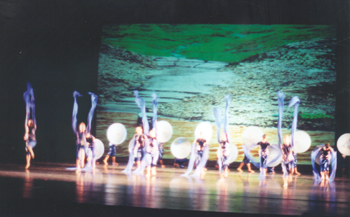


The third
movement opens with a Chinese flute solo of the Northern Shanxi style.
With the deep chord of the piano, the ladies on the banks of the Yellow River
are drowned by gigantic waves, represented by the umbrellas. The solo
dancer represents the spirit of the countless Chinese people who have drowned in
the river. At the end, the spirit foresees a bright future for the next
generation of young Chinese people. Although individuals may die, the
fighting spirit of the Chinese people lives on.
Choreography: Hwee-Eng Y. Lee and Kerry Lee
Solo Dancer: Kerry Lee
Sleeve Dancers: Hoyi Chan, Queena Kou, Amy Liu, Eugenie Ooi, Amanda
Phingbodhipakkiya, Joy Shieh, Tiffany Soo, Emily Sun, Joann Wang, Penny Wang
Umbrella Dancers: Grace Ho, April Huang, Deanna Joe, Dana Lee, Catherine
Stoddard, Melissa Ting, Ginger Tsai, Angela Wang, Emily Wang, Lacey Wen,
Kimberly Wu, Cindy Ye
[Top of page]
DEFEND
THE YELLOW RIVER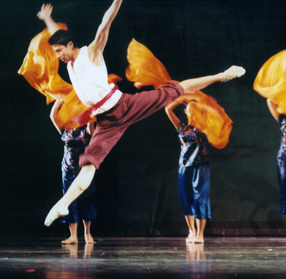
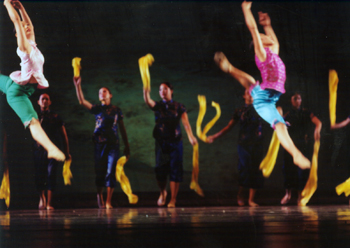
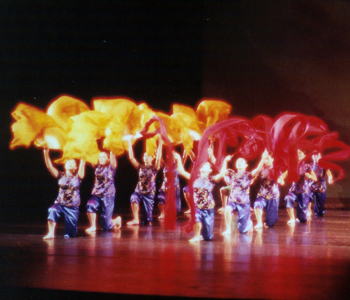
The fourth and final movement depicts the patriotism of the Chinese people.
The leading motif "Defend the Yellow River" continues throughout the piece as a
symbol of the people's march to battle. Some sections symbolize the war
horses. The triumphant climax praises the victories of the Chinese people.
This dance was originally choreographed for Beijing Dance Academy without the
use of any props.
Choreography after Zhang Yujun and Shen
Peiyi (Beijing Dance Academy) by Hwee-Eng Y. Lee
Lead Dancers: Kerry Lee, Amanda Phingbodhipakkiya, Tian Shuai (Guest
Artist, Atlanta Ballet)
Red Ribbon Dancers: Hoyi Chan, Susan
Chung, Queena Kou, Eugenie Ooi, Joy Shieh, Tiffany Soo, Emily Sun, Joann Wang,
Penny Wang, Grace Yen
Orange Fan Dancers: San Tso Hsieh, Tzu-Wei Hsu, Jane Lee, Grace Liang,
Amy Liu, Emily Pau, Natalie Perkins, Nicole Tocci, Angela Wang, Mei-Yuan Wang
Yellow Scarf Dancers: Nancy Chen,
Grace Ho, April Huang, Deanna Joe, Dana Lee, Catherine Stoddard, Melissa Ting,
Ginger Tsai, Emily Wang, Lacey Wen, Kimberly Wu, Cindy Ye
Additional Finale Dancers: Tara Lee
(Guest Artist, Atlanta Ballet), Tamila (Guest Artist, Atlanta Ballet)
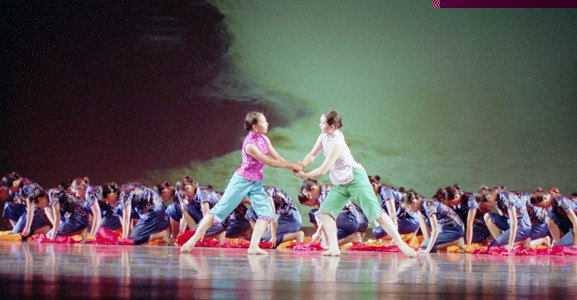

[Top of page]
Final
Bow

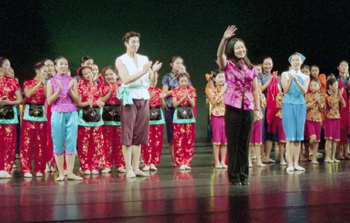
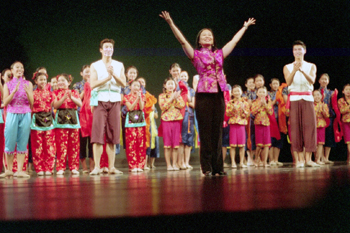
[Top of page]
Introduction
.|.
About
ACDC .|.
Past
Performances
Most
Recent Performance.|
.
Upcoming Performance
.
|.
Chinese
Dance History
Chinese
Dance Classes
Created by the Atlanta Chinese
Dance Company
Copyright reserved.
 Two
girls carry hats and fans from their house to sell. As they leave, they
water the carrot in their garden. All of the sudden, they encounter a
group of monkeys. The monkeys rob them of all of their goods, which
naturally makes the girls angry, but the clever girls think of a way to take
back their hats and fans. Year 2004 was the Chinese lunar new year of the
monkey.
Two
girls carry hats and fans from their house to sell. As they leave, they
water the carrot in their garden. All of the sudden, they encounter a
group of monkeys. The monkeys rob them of all of their goods, which
naturally makes the girls angry, but the clever girls think of a way to take
back their hats and fans. Year 2004 was the Chinese lunar new year of the
monkey. PULL
THE CARROT!
PULL
THE CARROT! The
folktale "Pull the Carrot!" has been passed down from generation to generation.
A young girl has grown a gigantic carrot. She tries unsuccessfully to pull
it alone. With the help of her friends, she is finally able to pull this
huge carrot out of the ground. Although this story is seemingly simple, it
has a very important underlying theme: although a daunting task may seem
impossible, much can be accomplished with perseverance and the aid of one's
friends.
The
folktale "Pull the Carrot!" has been passed down from generation to generation.
A young girl has grown a gigantic carrot. She tries unsuccessfully to pull
it alone. With the help of her friends, she is finally able to pull this
huge carrot out of the ground. Although this story is seemingly simple, it
has a very important underlying theme: although a daunting task may seem
impossible, much can be accomplished with perseverance and the aid of one's
friends. Xinjiang,
located in the northwestern part of China, is the home of the Uighur (or "wei wu
er") ethnic group. The province is renowned for its fruit and produce,
including grapes and melons. This dance depicts a group of young ladies
picking grapes. The interesting wrist and neck movements are the main
characteristics of this style.
Xinjiang,
located in the northwestern part of China, is the home of the Uighur (or "wei wu
er") ethnic group. The province is renowned for its fruit and produce,
including grapes and melons. This dance depicts a group of young ladies
picking grapes. The interesting wrist and neck movements are the main
characteristics of this style. This
playful dance, of the majority Han ethnicity, depicts a girl planting peppers.
Because the peppers are very hot, the girl sneezes repeatedly. This dance
depicts the daily life of a young Chinese village girl.
This
playful dance, of the majority Han ethnicity, depicts a girl planting peppers.
Because the peppers are very hot, the girl sneezes repeatedly. This dance
depicts the daily life of a young Chinese village girl.

 Rice
is a staple crop of China. In this dance of the majority Han ethnicity a
group of young village girls harvest their crop using authentic sieves.
The lyrics of the song tell how much each grain of rice requires hard work under
the blazing hot sun.
Rice
is a staple crop of China. In this dance of the majority Han ethnicity a
group of young village girls harvest their crop using authentic sieves.
The lyrics of the song tell how much each grain of rice requires hard work under
the blazing hot sun.
 NORTHEAST
FAN DANCE
NORTHEAST
FAN DANCE ZHUANG DANCE
ZHUANG DANCE
 TIBET
DANCE
TIBET
DANCE


 Traditionally,
red is the symbol of happiness. For centuries, the Chinese have taken
great pride in producing beautiful silk ribbons. Ribbon dancing originated
from Chinese opera and has been preserved since the Han dynasty (206 BC-24 AD).
It has since become a Han ethnic tradition, commonly performed at celebrations
such as Chinese New Year. Here the girls celebrate their success with the
huge carrot by inviting their friends of different ethnicities to take part in
the festivities.
Traditionally,
red is the symbol of happiness. For centuries, the Chinese have taken
great pride in producing beautiful silk ribbons. Ribbon dancing originated
from Chinese opera and has been preserved since the Han dynasty (206 BC-24 AD).
It has since become a Han ethnic tradition, commonly performed at celebrations
such as Chinese New Year. Here the girls celebrate their success with the
huge carrot by inviting their friends of different ethnicities to take part in
the festivities.

 DUNHUANG
DANCE: FLYING CELESTIALS
DUNHUANG
DANCE: FLYING CELESTIALS



 The
well-known story of Mulan tells of a young girl who went to war in place of her
father. This dance uses the recitation of the famous poem "Ode of Mulan"
in conjunction with background music. The story of Mulan as it is told
today comes directly from the words of this poem. Using classical Chinese
dance technique combined with wushu (Chinese martial arts), this dance
characterizes both Mulan's feminine and masculine sides.
The
well-known story of Mulan tells of a young girl who went to war in place of her
father. This dance uses the recitation of the famous poem "Ode of Mulan"
in conjunction with background music. The story of Mulan as it is told
today comes directly from the words of this poem. Using classical Chinese
dance technique combined with wushu (Chinese martial arts), this dance
characterizes both Mulan's feminine and masculine sides.


 The first movement depicts the
courage of the Yellow River boatmen who struggle against the river. The
work songs of the boatmen show the strong-willed fighting spirit of the Chinese
people. The slower section shows the boatmen's optimistic view of their
grueling struggle. Shortly after, the mood reverts to tension.
The first movement depicts the
courage of the Yellow River boatmen who struggle against the river. The
work songs of the boatmen show the strong-willed fighting spirit of the Chinese
people. The slower section shows the boatmen's optimistic view of their
grueling struggle. Shortly after, the mood reverts to tension.












